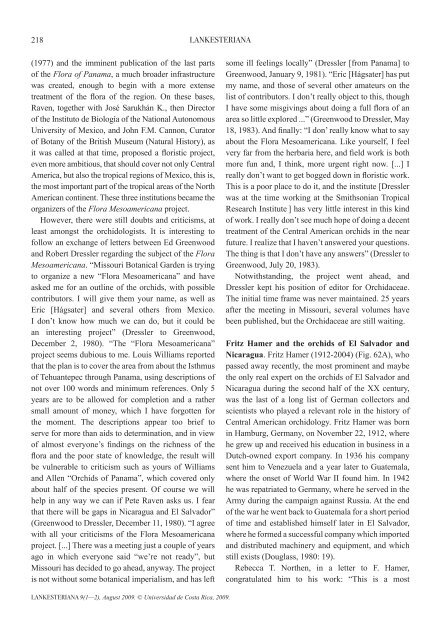orchids and orchidology in central america. 500 ... - lankesteriana.org
orchids and orchidology in central america. 500 ... - lankesteriana.org
orchids and orchidology in central america. 500 ... - lankesteriana.org
Create successful ePaper yourself
Turn your PDF publications into a flip-book with our unique Google optimized e-Paper software.
218<br />
(1977) <strong>and</strong> the imm<strong>in</strong>ent publication of the last parts<br />
of the Flora of Panama, a much broader <strong>in</strong>frastructure<br />
was created, enough to beg<strong>in</strong> with a more extense<br />
treatment of the flora of the region. On these bases,<br />
Raven, together with José Sarukhán K., then Director<br />
of the Instituto de Biología of the National Autonomous<br />
University of Mexico, <strong>and</strong> John F.M. Cannon, Curator<br />
of Botany of the British Museum (Natural History), as<br />
it was called at that time, proposed a floristic project,<br />
even more ambitious, that should cover not only Central<br />
America, but also the tropical regions of Mexico, this is,<br />
the most important part of the tropical areas of the North<br />
American cont<strong>in</strong>ent. These three <strong>in</strong>stitutions became the<br />
<strong>org</strong>anizers of the Flora Meso<strong>america</strong>na project.<br />
However, there were still doubts <strong>and</strong> criticisms, at<br />
least amongst the orchidologists. It is <strong>in</strong>terest<strong>in</strong>g to<br />
follow an exchange of letters between Ed Greenwood<br />
<strong>and</strong> Robert Dressler regard<strong>in</strong>g the subject of the Flora<br />
Meso<strong>america</strong>na. “Missouri Botanical Garden is try<strong>in</strong>g<br />
to <strong>org</strong>anize a new “Flora Meso<strong>america</strong>na” <strong>and</strong> have<br />
asked me for an outl<strong>in</strong>e of the <strong>orchids</strong>, with possible<br />
contributors. I will give them your name, as well as<br />
Eric [Hágsater] <strong>and</strong> several others from Mexico.<br />
I don’t know how much we can do, but it could be<br />
an <strong>in</strong>terest<strong>in</strong>g project” (Dressler to Greenwood,<br />
December 2, 1980). “The “Flora Meso<strong>america</strong>na”<br />
project seems dubious to me. Louis Williams reported<br />
that the plan is to cover the area from about the Isthmus<br />
of Tehuantepec through Panama, us<strong>in</strong>g descriptions of<br />
not over 100 words <strong>and</strong> m<strong>in</strong>imum references. Only 5<br />
years are to be allowed for completion <strong>and</strong> a rather<br />
small amount of money, which I have f<strong>org</strong>otten for<br />
the moment. The descriptions appear too brief to<br />
serve for more than aids to determ<strong>in</strong>ation, <strong>and</strong> <strong>in</strong> view<br />
of almost everyone’s f<strong>in</strong>d<strong>in</strong>gs on the richness of the<br />
flora <strong>and</strong> the poor state of knowledge, the result will<br />
be vulnerable to criticism such as yours of Williams<br />
<strong>and</strong> Allen “Orchids of Panama”, which covered only<br />
about half of the species present. Of course we will<br />
help <strong>in</strong> any way we can if Pete Raven asks us. I fear<br />
that there will be gaps <strong>in</strong> Nicaragua <strong>and</strong> El Salvador”<br />
(Greenwood to Dressler, December 11, 1980). “I agree<br />
with all your criticisms of the Flora Meso<strong>america</strong>na<br />
project. [...] There was a meet<strong>in</strong>g just a couple of years<br />
ago <strong>in</strong> which everyone said “we’re not ready”, but<br />
Missouri has decided to go ahead, anyway. The project<br />
is not without some botanical imperialism, <strong>and</strong> has left<br />
LANKESTERIANA<br />
LANKESTERIANA 9(1—2), August 2009. © Universidad de Costa Rica, 2009.<br />
some ill feel<strong>in</strong>gs locally” (Dressler [from Panama] to<br />
Greenwood, January 9, 1981). “Eric [Hágsater] has put<br />
my name, <strong>and</strong> those of several other amateurs on the<br />
list of contributors. I don’t really object to this, though<br />
I have some misgiv<strong>in</strong>gs about do<strong>in</strong>g a full flora of an<br />
area so little explored ...” (Greenwood to Dressler, May<br />
18, 1983). And f<strong>in</strong>ally: “I don’ really know what to say<br />
about the Flora Meso<strong>america</strong>na. Like yourself, I feel<br />
very far from the herbaria here, <strong>and</strong> field work is both<br />
more fun <strong>and</strong>, I th<strong>in</strong>k, more urgent right now. [...] I<br />
really don’t want to get bogged down <strong>in</strong> floristic work.<br />
This is a poor place to do it, <strong>and</strong> the <strong>in</strong>stitute [Dressler<br />
was at the time work<strong>in</strong>g at the Smithsonian Tropical<br />
Research Institute ] has very little <strong>in</strong>terest <strong>in</strong> this k<strong>in</strong>d<br />
of work. I really don’t see much hope of do<strong>in</strong>g a decent<br />
treatment of the Central American <strong>orchids</strong> <strong>in</strong> the near<br />
future. I realize that I haven’t answered your questions.<br />
The th<strong>in</strong>g is that I don’t have any answers” (Dressler to<br />
Greenwood, July 20, 1983).<br />
Notwithst<strong>and</strong><strong>in</strong>g, the project went ahead, <strong>and</strong><br />
Dressler kept his position of editor for Orchidaceae.<br />
The <strong>in</strong>itial time frame was never ma<strong>in</strong>ta<strong>in</strong>ed. 25 years<br />
after the meet<strong>in</strong>g <strong>in</strong> Missouri, several volumes have<br />
been published, but the Orchidaceae are still wait<strong>in</strong>g.<br />
Fritz Hamer <strong>and</strong> the <strong>orchids</strong> of El Salvador <strong>and</strong><br />
Nicaragua. Fritz Hamer (1912-2004) (Fig. 62A), who<br />
passed away recently, the most prom<strong>in</strong>ent <strong>and</strong> maybe<br />
the only real expert on the <strong>orchids</strong> of El Salvador <strong>and</strong><br />
Nicaragua dur<strong>in</strong>g the second half of the XX century,<br />
was the last of a long list of German collectors <strong>and</strong><br />
scientists who played a relevant role <strong>in</strong> the history of<br />
Central American <strong>orchidology</strong>. Fritz Hamer was born<br />
<strong>in</strong> Hamburg, Germany, on November 22, 1912, where<br />
he grew up <strong>and</strong> received his education <strong>in</strong> bus<strong>in</strong>ess <strong>in</strong> a<br />
Dutch-owned export company. In 1936 his company<br />
sent him to Venezuela <strong>and</strong> a year later to Guatemala,<br />
where the onset of World War II found him. In 1942<br />
he was repatriated to Germany, where he served <strong>in</strong> the<br />
Army dur<strong>in</strong>g the campaign aga<strong>in</strong>st Russia. At the end<br />
of the war he went back to Guatemala for a short period<br />
of time <strong>and</strong> established himself later <strong>in</strong> El Salvador,<br />
where he formed a successful company which imported<br />
<strong>and</strong> distributed mach<strong>in</strong>ery <strong>and</strong> equipment, <strong>and</strong> which<br />
still exists (Douglass, 1980: 19).<br />
Rebecca T. Northen, <strong>in</strong> a letter to F. Hamer,<br />
congratulated him to his work: “This is a most
















